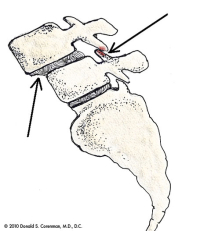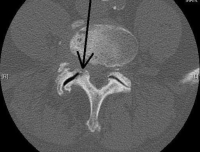Lumbar Degenerative Facet Disease Overview
There are many factors to consider as to why lower back pain exists. The lumbar facets are the joints in the back of the vertebra that are paired and hook the rear of the top vertebra to the back of the vertebra below. With movement, they are important in guiding the spine to track properly and create normal spinal alignment. The disk in front absorbs shock and dampens motion but it is the facets in back that are important to guide the motion of the vertebra like railroad tracks guide a train (read more Introduction to the Function of the Lumbar Spine).
When it comes to bearing weight, the disc in front carries almost 80% of the weight and the facets only 20%. This weight bearing distribution changes with forward and backward bending. Bending forward causes the disc to bear almost all the load and bending backwards causes the facets to bear almost 70% of the weight of the upper body.
The facets are real joints similar to a hip or knee joint. A joint is essentially a movable surface located where two bones join together. In this type of joint, called a diarthrodial joint, both joining bones have smooth caps of cartilage that covers the surfaces. These facet joints are held together with a strong flat sheet of collagen called a capsule that surrounds the joints. Lining this capsule is the synovium, a thin sheet of specialized cells that make the lubricant- synovial fluid- similar to WD 40 oil.
The joint surfaces are so perfectly matched and smooth that with the synovial fluid, there is a vacuum that holds the joints together. Breaking this vacuum causes a popping sound similar to removing a wet glass from a smooth counter. There is no danger in breaking this vacuum and it can feel quite good, as when a Chiropractor manipulates the spine.
Abnormal movement of the facets, as commonly seen with an associated degenerative disc can cause uneven wear of the cartilage and even cause some of the joint surface to sheer off. The smooth lining of these facets (the cartilage) has a very poor blood supply and cannot heal if injured. “Degenerative facet arthritis” or lumbar “degenerative facet disease” is the term used for the wearing down of the cartilage surfaces in the spine.
The facets mechanically are “door stops”. Looking carefully at a side view of a normal lumbar x-ray, the vertebra all line up perfectly. With lumbar degenerative facet disease, changes of the disc and the height of the disc is lost. The vertebra involved will slide backwards on the one below (called a retrolysthesis) because they are shaped like a ramp facing backwards. However, in spite of a degenerative disc being present, if the facets have worn out and eroded down, the vertebra will slide forward. This condition is called a degenerative spondylolysthesis. If the facets break off, the condition is called isthmic spondylolysthesis. Please see the separate section on this condition elsewhere in this web site. There is also a very informative video about degenerative spondylolysthesis (a common cause of lower back pain).
The facets, when they become degenerative, develop bone spurs. If the bone spurs push medially (inside the spinal canal), then lateral recess stenosis of the spine occurs (crowding of the traversing nerve root). If the spurs form in front, foraminal stenosis results (crowding of the exiting nerve root). If the facet spurs tear the capsule, a ganglion cyst can form which can cause stenosis in either location. Please see these topics covered elsewhere in this web site.

(Click to Enlarge Image) This picture shows the anatomy of a degenerative spondylolysthesis. The arrow in the front of the spine (left side of the picture) points to the step-off or slip of one vertebra on the one below. The arrow in back points to the cause of the slip, the wear of the facet joint allowing the slip.
Are you suffering from symptoms of lumbar degenerative facet disease?
Would you like to consult with Dr. Corenman about your condition?
You can set up a long distance consultation to discuss your
current X-rays and/or MRIs for a clinical case review.
(Please keep reading below for more information on this condition.)
Lumbar Degenerative Facet Disease Symptoms
Interesting enough, most of the time, lumbar degenerative facet disease is painless and does not cause chronic lower back pain. Many individuals have no significant pain receptors in the facets and it does not register in their brain that their facets have arthritis of the spine. Pain can be generated by nerve compression in the spine and that manifests as buttocks and leg pain. Lateral recess stenosis, lumbar foraminal stenosis, ganglion cysts in the spine, degenerative spondylolysthesis, central stenosis of the spine, and isthmic spondylolysthesis are the typical conditions that occur associated with degenerative facet disease. Instability of the lumbar spine can also occur with lumbar degenerative facet disease. All these conditions are covered in other chapters of this website.
Lumbar Degenerative Facet Disease Treatment
Non-Surgical
Treatment for lumbar degenerative facet disease is based upon the specific facet disease condition that is present (see above). In most cases, if there are no symptoms, there is no need for treatment. If the patient has actual facet pain from arthritis of the spine, physical therapy, chiropractic, medications, activity avoidance and facet injections can be helpful. If facet injections help but last only temporarily, dorsal facet rhizotomies can be effective.
A rhizotomy is an outpatient procedure that attempts to desensitize the facet by burning the small sensory nerves that supply the facet. Its effectiveness in the right setting is about 70% but may have to be repeated in one year as the sensory nerves attempt to grow back.
Surgical
Surgical treatment depends upon the cause of pain. If there is nerve compression and no significant instability, a simple decompression can be helpful. If instability is present, a fusion would be required.
If you are suffering from lower back problems, or have questions regarding lumbar degenerative facet disease, please contact Dr. Donald Corenman, spine specialist and back doctor offering diagnostic and surgical second opinions to patients in the USA and around the world.
Related Content
- When to Have Lower Back Surgery
- Causes of Lower Back Pain
- Normal Spinal Alignment
- How to Describe Your History and Symptoms of Lower Back and Leg Pain
- Best Questions to Ask When Interviewing a Spine Surgeon or Neurosurgeon
- Degenerative Spondylolisthesis
- Ganglion Cysts
- Isolated Disc Resorption-Lumbar Spine (IDR)
- Lumbar Spinal Stenosis (Central Stenosis)


